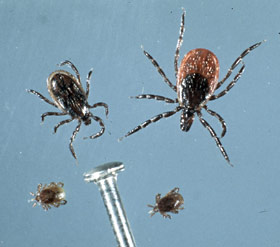Blacklegged (Deer) Tick, Ixodes scapularis

Blacklegged tick, Ixodes scapularis, life stages. Photo by Jim Occi, BugPics, Bugwood.org.
IPM Steps to Reduce Ticks
1. Sample for Pest
Where to find it while inspecting: Preferred tick habitat is transitional areas along edges of fields, lawns and woodlots where soil remains moist and there is a frequency of hosts passing through (this includes rodents, raccoons, deer, skunk and birds). Note: deer-footed mouse, a frequent building pest carries these ticks. Please see additional information (links below) about finding and removing ticks from humans.
2. Proper ID
Size and Particulars: Eggs and larvae are too small to see without magnification. Nymphs are only slightly bigger as the full size adults are roughly the size of a sesame seed (before feeding). Adults: 2.5 mm oval body. Females: orangish-brown but abdomen looks black when engorged. Males: more brown overall (males do not feed).
3. Learn the Pest Biology
Life Cycle: Generally a 2 (but up to 3) year life cycle. Adult ticks feed on mammals during winter; male dies after mating and female remains attached until spring when she can deposit up to 3,000 eggs. Larvae hatch during the warm season and need one good blood meal (at this time they are 6 legged). Depending on timing, they can molt and overwinter as 8 legged nymphs or remain larvae. Nymphs also need one good blood meal and are active from April through August, peaking in June or July. If they’ve had a blood meal, they will then molt into 8 legged adults before winter.
Preferred Food Sources: Blood.
Preferred Habitat: Field grasses and low-lying shrubbery. Often at the edge of fields, lawns and woodlots, much less often on mowed lawns. Area must have host activity: deer, rodents and birds. Nymphs most often found on small rodents.
4. Determine Threshold
Threshold: Zero due to risk of disease.
5. Choose Tactics
Best Management Practices: To reduce risk of tick encounters on school property, keep students and staff away from tall grass. Create a border with fencing or mulch that serves to keep students at least 3 feet away from the edge of tick habitat. Keep grass mowed low next to habitat and educate teachers, staff, students and parents to avoid those areas. See the excellent resources below, especially the Connecticut handbook, for ways to incorporate tick-free borders.
Treatment Methods: Aim to reduce tick habitat on and near school grounds. In extreme cases, certain acaricides (pesticides for mites and ticks) can be applied along these borders. Keeping rodents and deer away is also an important way to reduce the chance of tick exposure: reduce leaf litter, reduce rodent access to food source, fence against deer when possible.
6. Evaluate
Was the tactic successful? Record the date pests were first noted, and the tactic you used, and its success. Use one of our RECORD KEEPING tools.
For More Information
Connecticut Lyme Disease Prevention Project Tick Management Handbook
Cornell's Insect Diagnostic Laboratory: Integrated Pest Management for the Deer Tick
University of Rhode Island Tick Encounter Resource Center
Remember:
When a pesticide application is necessary, all necessary and required precautions are taken to minimize risk to people and the environment and to minimize risk of pesticide resistance or pest resurgence. Pesticide use in your school may be prohibited or regulated by local policies or state and federal regulations. Risk reduction methods can include, but are not limited to, spot-treatment, the use of gel or paste bait formulations placed in inaccessible locations, injection into a crack or crevice, and other methods that reduce potential exposure.